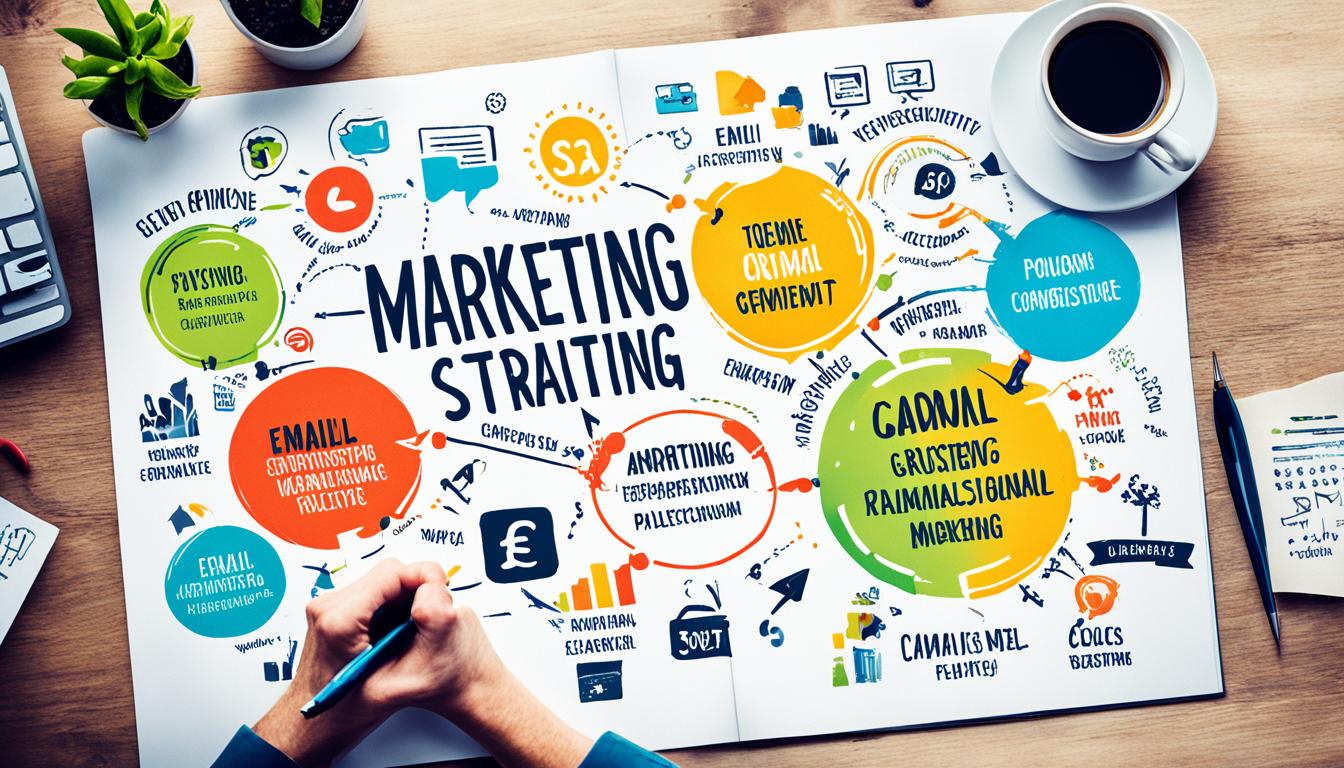A surprising 87% of people think their industry and business will face digital disruption1. This shows how important a good strategic growth plan is to stay ahead. I’ll share how to make a business development strategy that boosts growth and success. Start by looking at the strategic planning process for retail, which works for many industries. Knowing what customers want helps businesses create a plan that meets their needs1.
Boost your skills with our digital library! Explore top-notch e-books, courses, and web design resources. Plus, don’t miss our FREE webinars. Elevate your learning today at digitals.anthonydoty.com!
Key Takeaways
- Developing a strategic growth plan is key for businesses to compete in the digital world.
- Understanding what customers want is vital for a good growth strategy.
- A deep market analysis is needed to find the right markets and offer what they need1.
- Using customer analytics tech can add value at every customer stage2.
- Businesses should focus on real-time inventory and order-routing in their SaaS systems to meet customer expectations2.
- Getting certified by the U.S. Department of Treasury’s CDFI Fund can open doors to financial help, like grants and tax credits3.
Understanding Strategic Growth Planning
Exploring strategic growth planning shows its key role in today’s digital world. Strategic planning for business growth is vital for lasting success. Companies with clear visions and missions are 30% more likely to reach their growth goals4. Doing a SWOT analysis can boost a company’s strategic decision-making by 25%4.
To craft a solid growth strategy, knowing the different growth strategies is key. This includes organic growth, strategic growth, and growth through mergers or partnerships. Long-term growth planning means setting clear goals and using resources wisely. Businesses that focus on resource allocation are 35% more likely to hit their growth targets4. Good action plans can increase project success by up to 45%4.
Only 25% of companies manage to grow sustainably over time5. Those who grow sustainably outperform others by seven percentage points in annual returns5. Companies that add sustainability to their strategies see a five-percentage-point boost in total shareholder return (TSR)5. By adding strategic growth initiatives to their plans, companies can grow sustainably and beat their competitors.
Understanding strategic growth planning is key to long-term success. Companies should develop a detailed growth strategy that matches their goals. Regularly reviewing and tweaking this strategy is vital for lasting growth.
Key Components of Effective Growth Plans
Understanding the key parts of a growth plan is vital for business success. Growth planning and analysis help spot areas for improvement. A business growth plan outlines how to increase revenue for long-term success6.
It involves market research and setting clear goals. This ensures resources are used wisely.
A good growth plan includes revenue targets, cost estimates, and financial forecasts6. It also looks at challenges like economic issues and competition6. Strategic growth consulting helps tailor plans to fit each business’s needs.
Some important parts of a growth plan are:
- Market research and competition analysis
- Clear, measurable goals using the SMART framework6
- Effective resource allocation
- A detailed financial plan, including cash flow and break-even analyses6
By including these elements, your business can thrive and meet its growth goals.
Implementing Your Strategic Growth Plan
To successfully execute a growth strategy execution, you need a clear roadmap. This roadmap should be actionable and involve your team. It’s important to share your strategy with everyone, build a strong team, and track how you’re doing7.
A good strategic plan helps build a strong culture. It makes sure everyone is working towards the same goals7.
Effective strategic growth planning starts with knowing your business and market well. You should do market research, set clear goals, and use your resources wisely. This way, you can make a business development strategy that leads to growth and success. A formal strategic planning process can improve your organization’s performance by 30% on average7.
Here are some key steps to implement your strategic growth plan:
- Develop a detailed strategic plan with SMART goals
- Get your team involved in the planning to keep everyone motivated and on the same page
- Keep an eye on how you’re doing and make changes when needed to stay on course

By taking these steps and using the right tools, you can make your strategic growth plan work. Always check and update your plan to keep it effective8.
Tools and Resources for Strategic Growth
To support your strategic growth, using the right tools and resources is key. This includes technology like CRM software, marketing automation, and analytics. These tools help automate tasks, boost efficiency, and enhance customer experience9. Studies show companies that plan regularly grow 12% faster than those that don’t10.
For planning and analysis, many frameworks and tools are available. The Balanced Scorecard, SWOT analysis, and OKR framework are some examples. These tools help align your organization with its long-term vision, boosting strategy effectiveness up to 85%10. You can learn more about these tools on websites like strategic planning tools.
There are also books, courses, and webinars that offer insights and strategies for growth. These resources help you understand strategic growth initiatives and how to apply them in your organization. By using these tools and resources, you can increase your chances of success and meet your strategic growth goals9.
Some recommended resources include:
- Books on strategic planning and growth strategy
- Courses on marketing automation and analytics
- Webinars on OKR framework and Balanced Scorecard
By using these resources, you can keep up with the latest trends and best practices in strategic growth. This helps you make informed decisions to drive your organization’s success10.
Continuous Improvement in Growth Strategies
Strategic growth planning is not a one-time task. It’s a continuous process that needs ongoing effort and change11. It’s vital to check how well your growth strategy works and tweak it when needed. This keeps your business competitive and in line with market changes11.
Improvement comes from using data to make decisions11. Watching your progress and listening to customers helps you make better choices. This boosts your marketing and drives growth11. Working together across different parts of your company also helps. It breaks down barriers and brings new ideas to the table11.
Being open to change is key to growth11. Being flexible lets you quickly adapt to new situations. This approach keeps your customers happy and loyal, helping your business grow over time11.
For lasting growth and profit, keep refining your strategies11. Use the insights from this guide to set your business up for success. This will help you thrive in the digital world11.
FAQ
What is strategic growth planning?
Strategic growth planning is about making a detailed plan to grow your business. It aims to increase revenue and profits over time. You analyze market trends, set goals, and use resources to support your growth.
Why is strategic growth planning important in the digital landscape?
In today’s digital world, planning for growth is key to staying ahead. It helps businesses meet their goals by using technology and adapting to market changes.
What are the key components of an effective growth plan?
A good growth plan includes market analysis, clear goals, and resource allocation. This ensures your plan is informed, aligned with your goals, and has the resources needed for success.
How do I effectively implement my strategic growth plan?
To implement your plan well, create a detailed roadmap and track progress. Adjust as needed. Engage your team and clearly communicate the plan for success.
What tools and resources are available to support my strategic growth planning?
Many tools and resources can help with your growth plan. This includes CRM software, marketing tools, and analytics. There are also books, courses, and webinars for insights and strategies.
How do I ensure continuous improvement in my growth strategies?
Improve your strategies by regularly checking outcomes and adapting to changes. Seek advice from growth experts to keep your strategy aligned with your goals.








